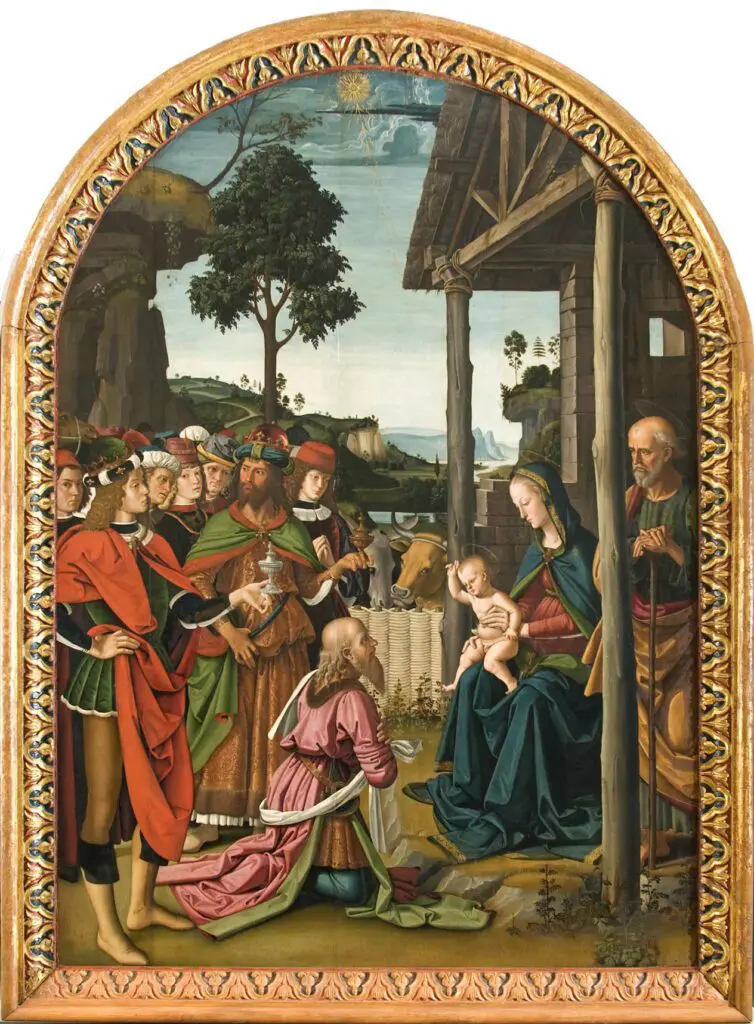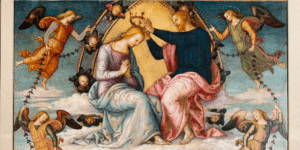From Perugino’s masterpieces in the National Gallery of Umbria: The Adoration of the Magi
The Adoration of the Magi (or Three Wise Men) is a very important painting in Pietro Vannucci’s career since it is mentioned by Giorgio Vasari as one of the first works he made in Perugia. From Vasari we also learn that the “divine painter” was in Perugia on July 21, 1475, when he was given 5 florins to make some paintings in the Palace of Priors. Vasari’s witness and the payment document provide us with useful data about the chronological setting of the Adoration; and a confirmation comes by likening it with a fresco Perugino made in Deruta (not far from Perugia) between 1475 and 1478. There, in fact, the face of one of the two saints, Saint Roch, looks much like King Baldassar’s in the Perugia panel.
The oil panel – one of the first works of that kind in Umbria – was set in the Church of Santa Maria dei Servi, “Saint Mary of the Servants” in Colle Landone, Perugia, that was the area in which the Baglioni family lived, who then ruled the town; precisely they had commissioned the painting. It is currently on exhibition in the National Gallery of Umbria, in a room dedicated to Pietro Vannucci’s works.

The Adoration of the Magi: A closer look
The Three Wise Men, richly clad, fill the left side of the composition together with their retinue. On the right we see the hut with the Sacred Family: Virgin Mary, dressed in red and wearing a blue cloak, holds the Infant Jesus, who blesses the Magi; Joseph watches everything and reflects. The ox and the donkey pop up peacefully from behind a fence that closes the scene in the foreground. In the background, a river landscape appears in which unnatural rocks are studded with gentle trees. The main tree in the background clearly recalls Piero Della Francesca while being set in a landscape deeply influenced by Leonardo Da Vinci.
The style in this painting still echoes the Late Gothic general lines, as was also the case with Benedetto Bonfigli’s Adoration of the Magi. There, too, the Wise Men bringing gifts to the newborn Christ are followed by their retinue, and their travel ends before a hut whose walls are topped with a truss roof (wood beams in a triangular structure). At the same time, Perugino brought to his adopted town the elements he had learned in Florence in Verrocchio’s workshop. It may therefore prove useful to make a comparison with the same subject matter as was painted by another pupil of Verrocchio, Sandro Botticelli, about 1475. It is currently on exhibition at the Uffizi Museum in Florence.
Comparing Perugino’s and Botticelli’s Adorations
In these works it is easy to detect some points of contact. Sandro Botticelli inserted a self-portrait in his painting, so did Pietro Vannucci in his Perugia panel: he can be identified with the man on the left in a red headgear and black clothes, looking toward us. Both artists, moreover, depicted the three ages of Man in the Magi.
Besides, in Botticelli’s panel we can recognize three members of the Medici family, respectively Cosimo, Piero il Gottoso (the Gouty), and Giovanni. In Perugino’s oil painting, too, do the Magi carry the features of illustrious personages: the artist’s very client, Braccio Baglioni, standing and sternly looking at the second Wise Man; his son, Grifone, on the left in the lower area of the panel; and Malatesta di Pandolfo as the third king, kneeling. The colors in which the three men’s clothes are dyed, green and red, were the colors of the Baglioni family.









